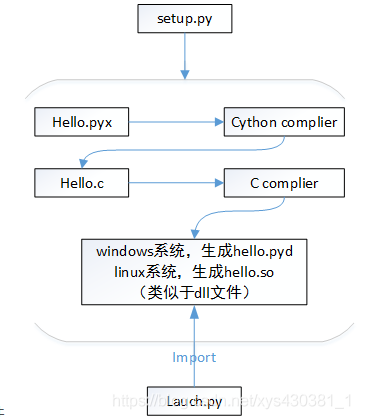cython 的认识
经常听到 cpython 的概念,这个概念和 python 有什么联系呢?
什么是 cython?
- Cython 是一个快速生成 Python 扩展模块的工具
- 从语法层面上来讲是 Python 语法和 C 语言语法的混血
- 当 Python 性能遇到瓶颈时,Cython 直接将 C 的原生速度植入 Python 程序,这样使 Python 程序无需使用 C 重写,能快速整合原有的 Python 程序,这样使得开发效率和执行效率都有很大的提高,而这些中间的部分,都是 Cython 帮我们做了
cython 有哪些优势?
- 编写 python 代码,通过 cython,可以方便地嵌入到 C/C++ 代码中
- 通过静态类型声明,将 Python 代码运行速度提升到 C 语言级别
- 使用组合的源代码级别 debugging,方便在 Python、C、C++ 之间调试
- 有效与大型数据集交互,比如 Numpy
什么是 cython 编程语言?
- cython 编程语言是 python 编程语言的超集
- 还支持调用 C 函数和在变量和类属性上声明 C 类型
Cython 与 CPython 有什么区别?
- Cython 是一种混合编程语言,可以让 Python 调用 C++ 的容器,例如 vector
- CPython 是一种被广泛使用的 python 解释器,类似的解释器还有 pypy,JPython 等等
.py、.pxd、.pyx、pyc、pyo、.pyd 分别是什么文件?
- .py : python 的源代码文件
- .pxd: 文件是由 Cython 编程语言 “编写” 而成的 Python 扩展模块头文件,类似于 C 语言的 .h 头文件,.pxd 文件中有 Cython 模块要包含的 Cython 声明 (或代码段) , 可共享外部 C 语言声明,也能包含 C 编译器内联函数。.pxd 文件还可为 .pyx 文件模块提供 Cython 接口,以便其它 Cython 模块可使用比 Python 更高效的协议与之进行通信
- .pyx : 由 Cython 编程语言 “编写” 而成的 Python 扩展模块源代码文件,类似于 C 语言的 .c 源代码文件,.pyx 文件中有 Cython 模块的源代码,不像 Python 语言可直接解释使用的 .py 文件,.pyx 文件必须先被编译成 .c 文件,再编译成 .pyd (Windows 平台) 或 .so (Linux 平台) 文件,才可作为模块 import 导入使用
- .pyc: Python 源代码 import 后,编译生成的字节码
- .pyo: Python 源代码编译优化生成的字节码。pyo 比 pyc 并没有优化多少,只是去掉了断言
- .pyd: 非 Python,由其它编程语言 “编写 - 编译” 生成的 Python 扩展模块,相当于 windows 下的 Python 动态链接库
- .py, .pyc, .pyo 运行速度几乎无差别,只是 pyc, pyo 文件加载的速度更快,但不能用文本编辑器查看内容,反编译不太容易
cython 的工作流程?
如何获得.pyx 文件?
- 如果该文件不含 cython 特有的语法,可以直接将.py 文件替换为.pyx 文件
- 如果含有 cython 特有语法,则需要手动编写 cython 语言
cython 的基本使用方法?
- 使用 Cython 编译 Python 代码时,务必要安装 C/C++ 编译器(windows 可以直接安装 Visiual Studio 的开发环境)
- 安装 Cython 库
1
pip install Cython
- 编写.pyx 文件,如 test.pyx(或者直接写.py 也可以?只要文件里不使用 cpython 独有的语法,而是使用纯 python 语法)
1
2def say_hello():
print("hello world") - 编写 setup.py 文件
1
2
3
4
5# cythonize()是Cython提供将Python代码转换成C代码的API
# setup是Python提供的一种发布Python模块的方法
from distutils.core import setup
from Cython.Build import cythonize
setup(ext_modules = cythonize("test.py")) - 编译
1
2
3# build_ext是指明python生成C/C++的扩展模块(build C/C++ extensions (compile/link to build directory))
# --inplace指示 将编译后的扩展模块直接放在与test.py同级的目录中
python setup.py build_ext --inplace - 使用
1
2
3# 像使用Python的任意模块一样,直接import即可
import test
test.say_hello()
使用 Cython 优化自定义函数?
- 创建.pyx 文件
1
cp compute.py compute1.pyx
- 创建 setup.py
1
2
3
4
5
6
7# setup1.py
from distutils.core import setup
from Cython.Build import cythonize
setup(
name='compute_module',
ext_modules=cythonize('compute1.pyx'),
) - 编译.pyx 文件
1
python setup1.py build
![]()
使用案例比较说明 Cython 和 Python 程序性能提升?
- 自定义函数
1
2
3
4
5
6
7
8
9
10
11
12
13
14
15
16
17# compute.py
# coding=utf-8
import math
def spherical_distance(lon1, lat1, lon2, lat2):
radius = 3956
x = math.pi/180.0
a = (90.0 - lat1)*x
b = (90.0 - lat2)*x
theta = (lon2 - lon1)*x
distance = math.acos(math.cos(a)*math.cos(b)) + (math.sin(a) * math.sin(b) * math.cos(theta))
return radius * distance
def f_compute(a, x, N):
s = 0
dx = (x - a)/N
for i in range(N):
s += ((a + i * dx) ** 2 - (a + i * dx))
return s * dx - 性能测试
1
2
3
4
5
6
7
8
9
10
11
12
13
14
15# test.py
#!/usr/bin/env python
# coding=utf-8
import compute
import time
lon1, lat1, lon2, lat2 = -72.345, 34.323, -61.823, 54.826
start_time = time.clock()
compute.f_compute(3.2, 6.9, 1000000)
end_time = time.clock()
print "runing1 time: %f s" % (end_time - start_time)
start_time = time.clock()
for i in range(1000000):
compute.spherical_distance(lon1, lat1, lon2, lat2)
end_time = time.clock()
print "runing2 time: %f s" % (end_time - start_time) ![]()
使用案例比较说明 Cython 和 Python 在使用 numpy 时的性能比较?
- 原始 python 代码
1
2
3
4
5
6
7
8
9
10
11
12
13
14# dot_python.py
import numpy as np
def naive_dot(a, b):
if a.shape[1] != b.shape[0]:
raise ValueError('shape not matched')
n, p, m = a.shape[0], a.shape[1], b.shape[1]
c = np.zeros((n, m), dtype=np.float32)
for i in xrange(n):
for j in xrange(m):
s = 0
for k in xrange(p):
s += a[i, k] * b[k, j]
c[i, j] = s
return c - .pyx 代码
1
2
3
4
5
6
7
8
9
10
11
12
13
14
15
16
17
18
19
20
21
22
23# dot_cython.pyx
import numpy as np
cimport numpy as np
cimport cython
@cython.boundscheck(False)
@cython.wraparound(False)
cdef np.ndarray[np.float32_t, ndim=2] _naive_dot(np.ndarray[np.float32_t, ndim=2] a, np.ndarray[np.float32_t, ndim=2] b):
cdef np.ndarray[np.float32_t, ndim=2] c
cdef int n, p, m
cdef np.float32_t s
if a.shape[1] != b.shape[0]:
raise ValueError('shape not matched')
n, p, m = a.shape[0], a.shape[1], b.shape[1]
c = np.zeros((n, m), dtype=np.float32)
for i in xrange(n):
for j in xrange(m):
s = 0
for k in xrange(p):
s += a[i, k] * b[k, j]
c[i, j] = s
return c
def naive_dot(a, b):
return _naive_dot(a, b) - 性能比较
1
2
3
4
5
6
7
8
9
10
11In [4]: a = np.random.randn(30, 50).astype(np.float32)
In [5]: b = np.random.randn(50, 20).astype(np.float32)
In [6]: %timeit -n 100 -r 3 dot_python.naive_dot(a, b)
13.9 ms ± 44.6 µs per loop (mean ± std. dev. of 3 runs, 100 loops each)
In [7]: %timeit -n 100 -r 3 dot_cython.naive_dot(a, b)
35.3 µs ± 11.3 µs per loop (mean ± std. dev. of 3 runs, 100 loops each)
In [8]: %timeit -n 100 -r 3 np.dot(a, b)
The slowest run took 23.35 times longer than the fastest. This could mean that an intermediate result is being cached.
135 µs ± 169 µs per loop (mean ± std. dev. of 3 runs, 100 loops each)
In [9]: %timeit -n 100 -r 3 np.dot(a, b)
17.2 µs ± 4.48 µs per loop (mean ± std. dev. of 3 runs, 100 loops each)


